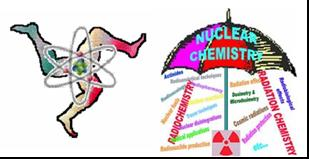Prof.
Xiaolin Hou
(Risø National Laboratory for Sustainable Energy, Technical University of Denmark)
22/09/2011, 11:00
Radioanalytical Chemistry and Nanoparticles
oral presentation
With the increasing threat of potential nuclear terrorism and radiological accidents, establishment of a rapid reaction system under nuclear emergency preparedness is an urgent requirement for reducing the health risk to the public. Rapid determination of radionuclides in large number of biological and environmental samples is a key and crucial step in the emergency process and determines the...
Prof.
Dominic Lariviere
(Université Laval)
22/09/2011, 11:20
Radioanalytical Chemistry and Nanoparticles
oral presentation
Many radioisotopes are released in the environment from our use of the nuclear energy. Among these, actinides are a health concern due to their long environmental persistence and the risk associated with internal dosimetry. The simultaneous analysis of actinides (i.e. Th, U, Np, Pu and Am) is labour-intensive because 1) they are found at ultra trace levels, 2) are difficult to dissolve, 3)...
Dr
Yutaka MIYAMOTO
(JAEA (Japan Atomic Energy Agency))
22/09/2011, 11:35
Radioanalytical Chemistry and Nanoparticles
oral presentation
Abundance and isotopic ratios of trace uranium (U), thorium (Th), lead (Pb) and lanthanides in environmental samples play a key role to investigate features of the samples. The analytical data may give information on origin of the sample, dating of mineral formation, history on mineralization, and age determination of nuclear materials. Abundance and isotopic ratios of an element of interest...
Mr
Nils Stoebener
(University of Mainz - Institute of Nuclear Chemistry)
22/09/2011, 11:50
Radioanalytical Chemistry and Nanoparticles
oral presentation
Long-lived isotopes of the actinides are the major contributors to the radiotoxicity of spent nuclear fuel after a storage time of 1000 years. Especially Np-237 is considered as a potential hazard to the environment because of its long half-life of 2.14 million years and high mobility in aquatic systems. Since the concentration of Np-237 expected in case of a leakage of a nuclear waste...
Wouter Schroeyers
(CMK (UHasselt) and NuTeC (XIOS Hogeschool Limburg))
22/09/2011, 12:20
Radioanalytical Chemistry and Nanoparticles
oral presentation
Background: Recently the European Commission is recasting the Euratom Basic Safety Standards (BSS) in order to further limit the exposure of the public and workers to radioactivity. The new BSS is expected in 2015 and contains a broad list of industries, processing Naturally Occurring Radioactive Material (NORM), that will become subject to more strict regulation. The list contains, among...
